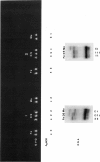Abstract
Nondisjunction in trisomy 21 has traditionally been studied by cytogenetic heteromorphisms. Those studies assumed no crossing-over on the short arm of chromosome 21. Recently, increased accuracy of detection of the origin of nondisjunction has been demonstrated by DNA polymorphism analysis. We describe a comparative study of cytogenetic heteromorphisms and seven PCR-based DNA polymorphisms for detecting the origin of the additional chromosome 21 in 68 cases of Down syndrome. The polymorphisms studied were the highly informative microsatellites at loci D21S215, D21S120, D21S192, IFNAR, D21S156, HMG14, and D21S171. The meiotic stage of nondisjunction was assigned on the basis of the pericentromeric markers D21S215, D21S120, and D21S192. Only unequivocal cytogenetic results were compared with the results of the DNA analysis. The parental and meiotic division origin could be determined in 51% of the cases by using the cytogenetic markers and in 88% of the cases by using the DNA markers. Although there were no discrepancies between the two scoring systems regarding parental origin, there were eight discrepancies regarding meiotic stage of nondisjunction. Our results raise the possibility of recombination between the two marker systems, particularly on the short arm.
Full text
PDF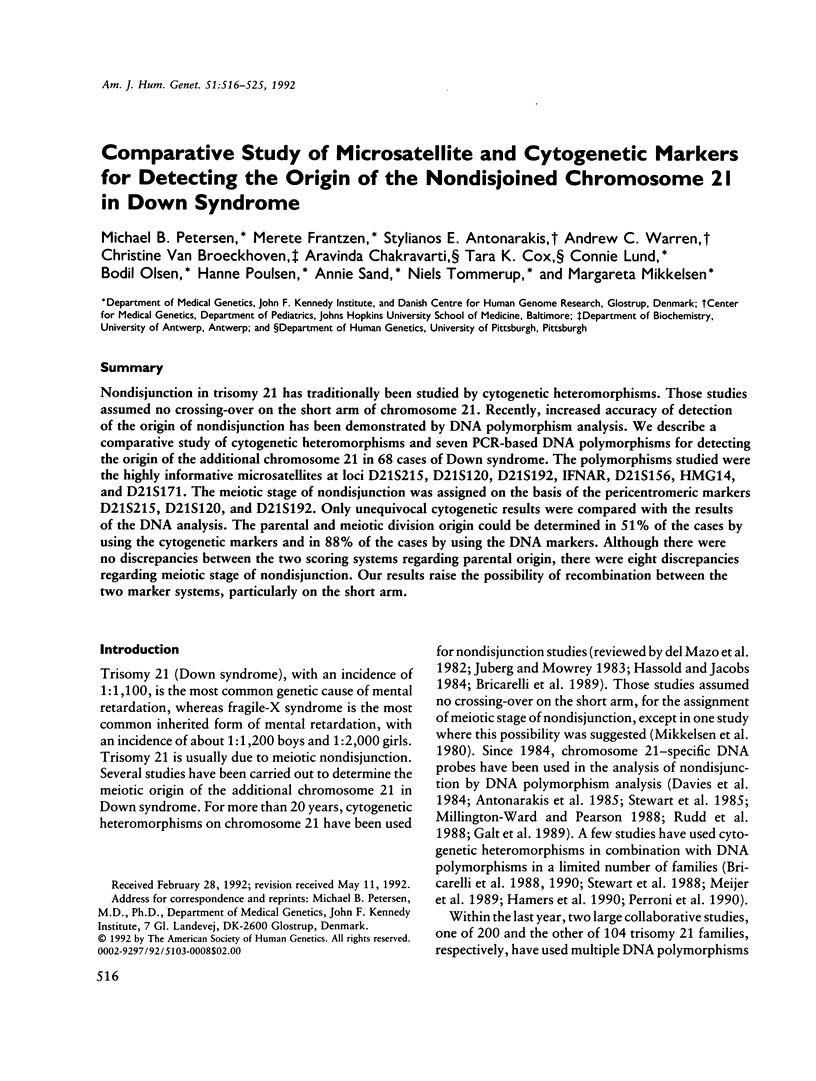
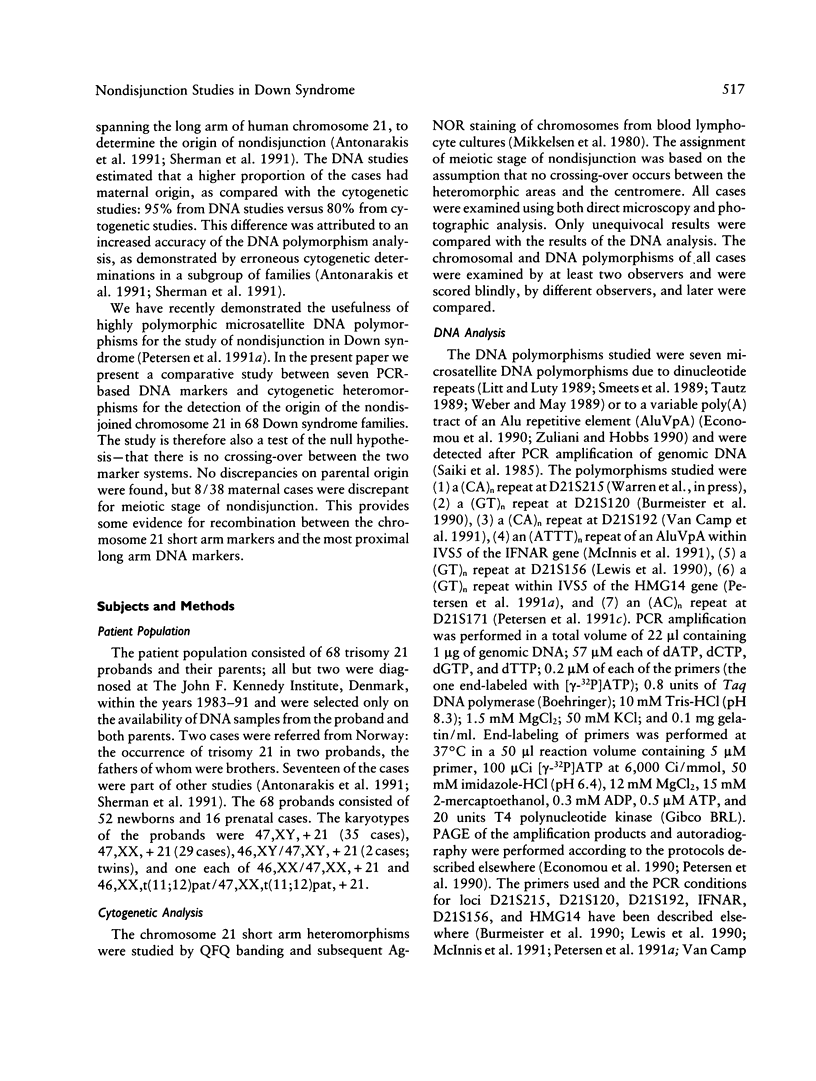
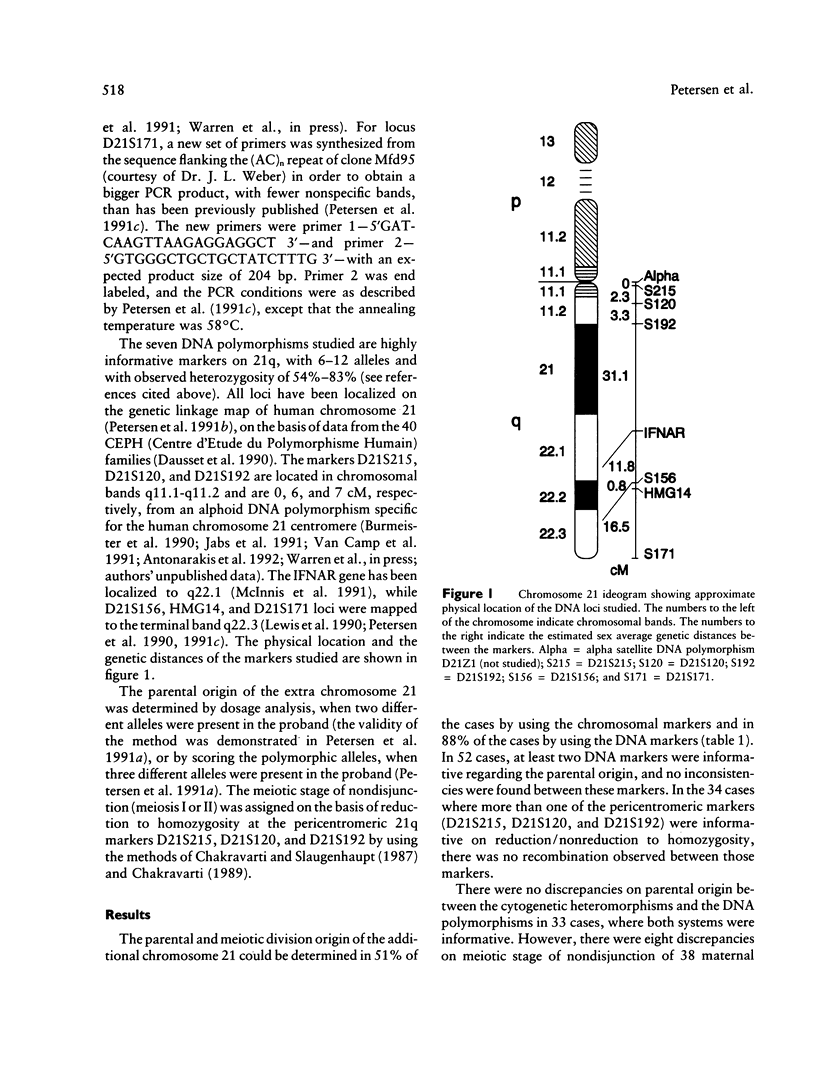
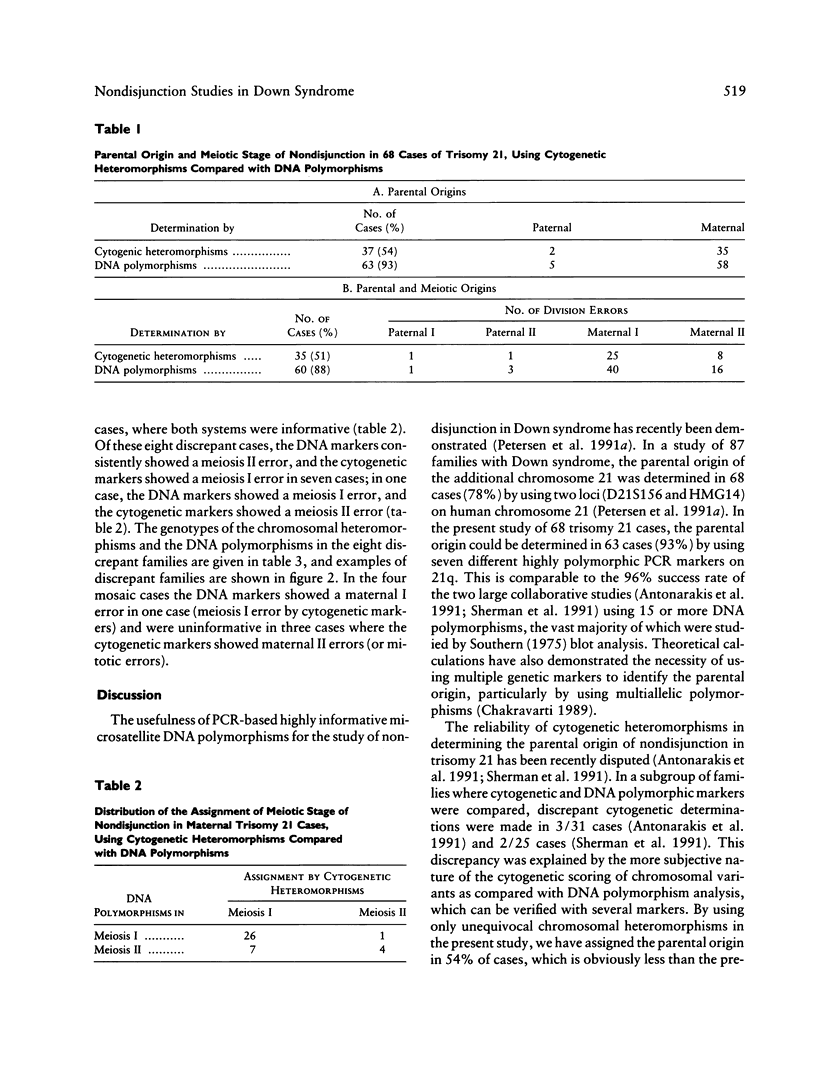
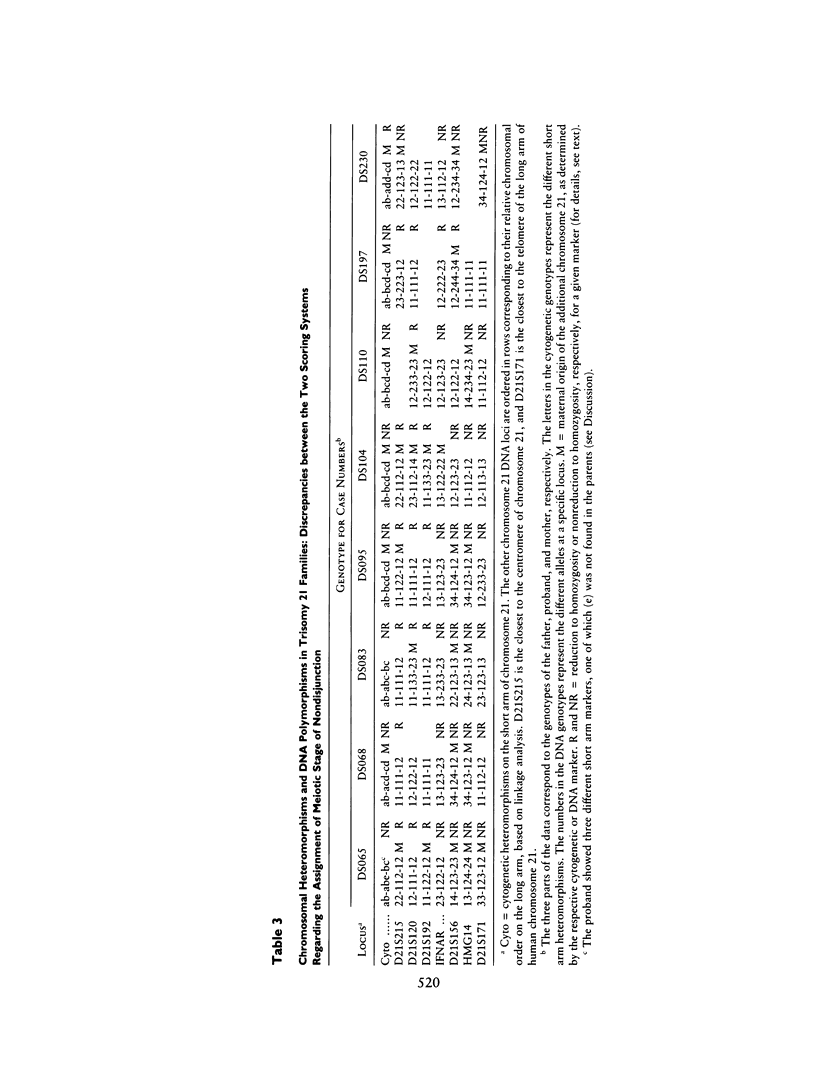
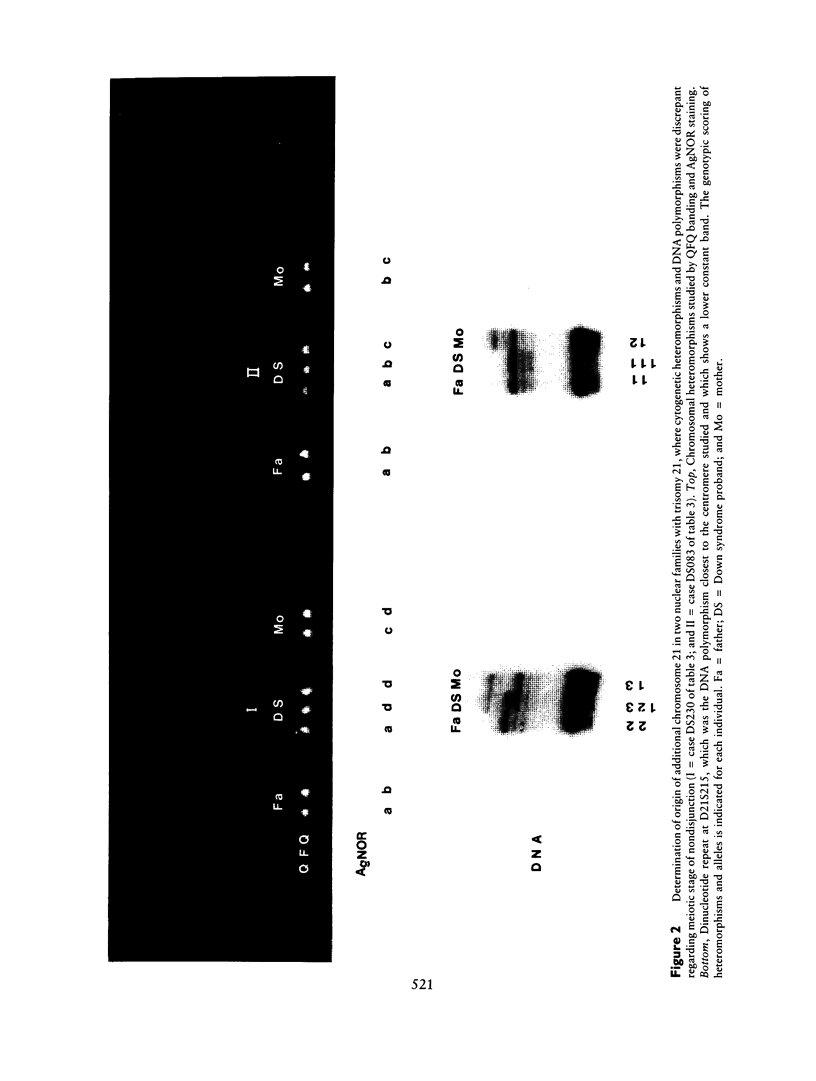
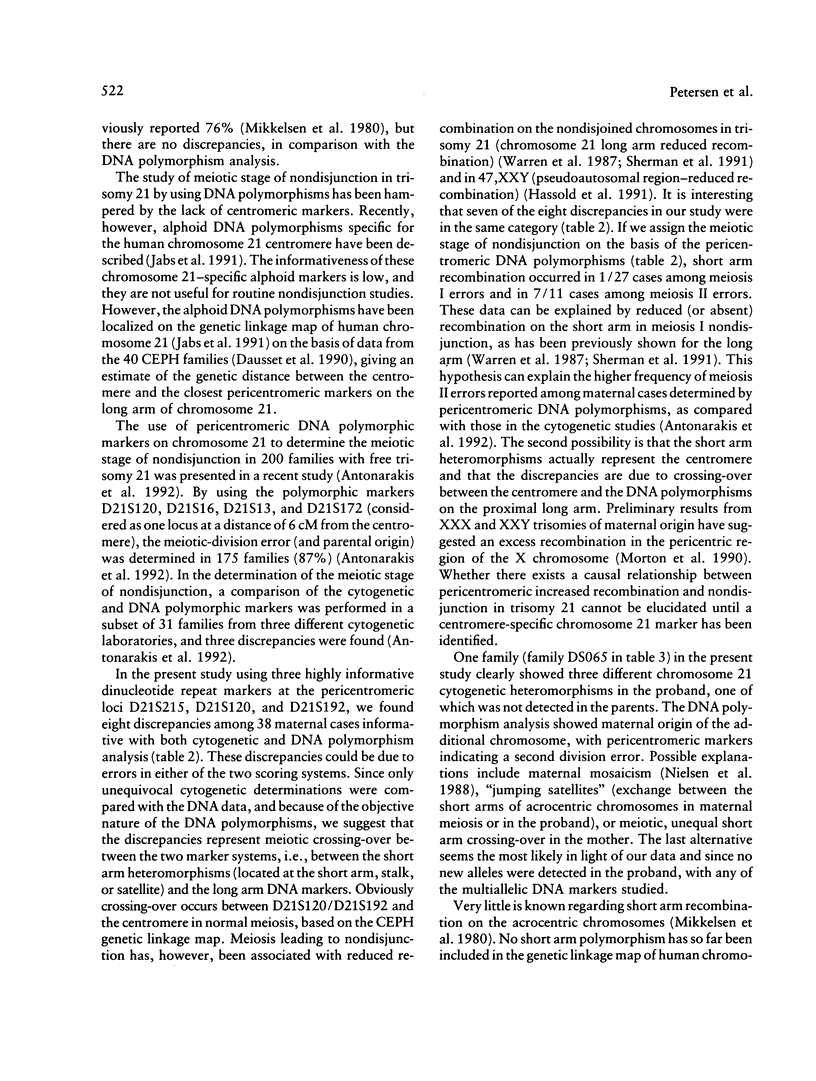
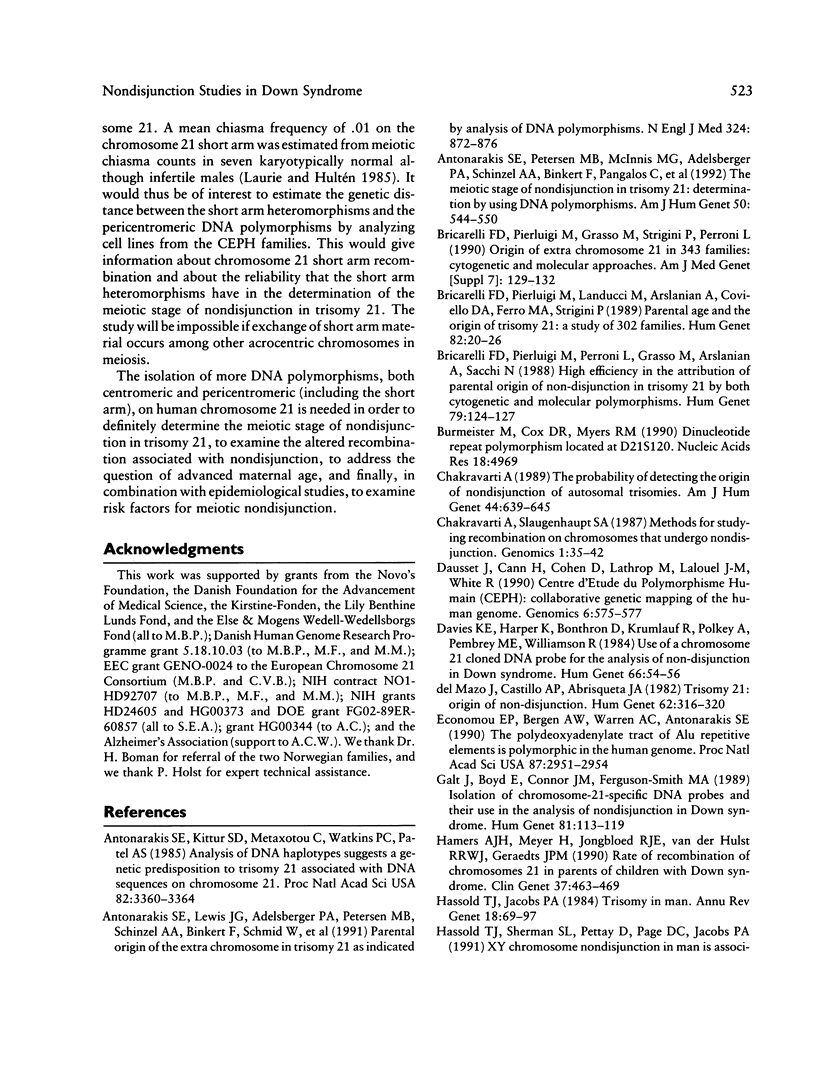
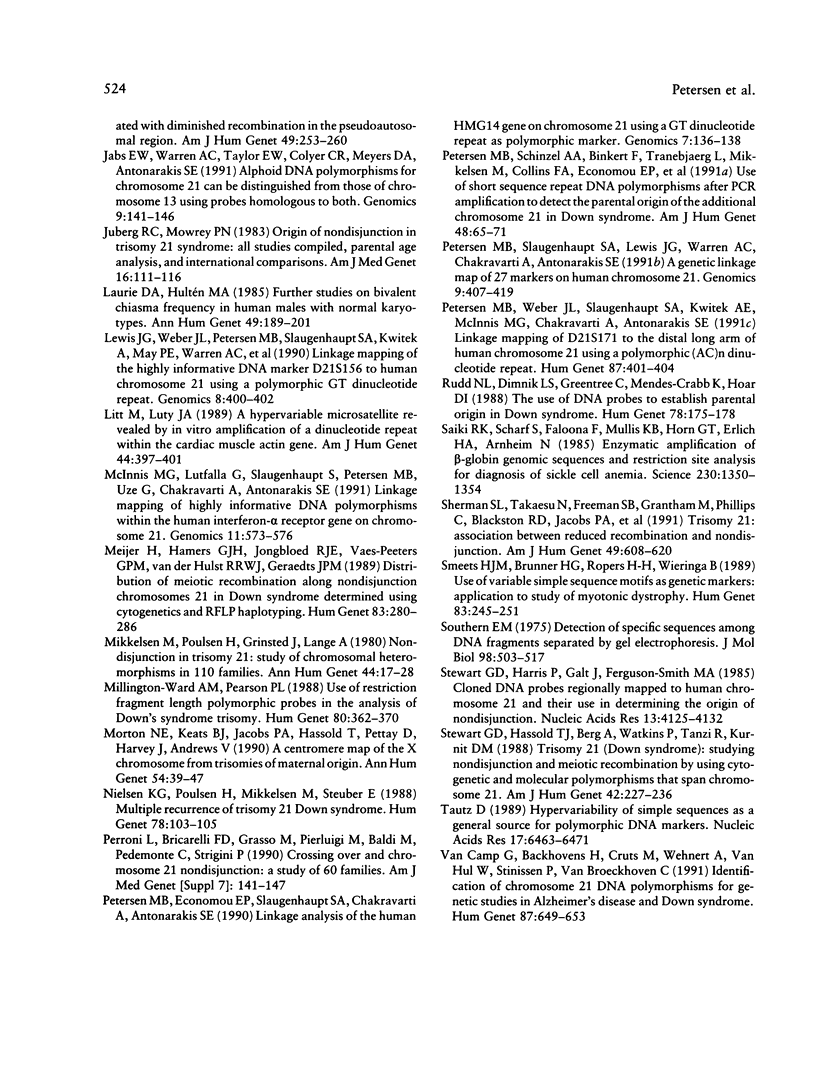
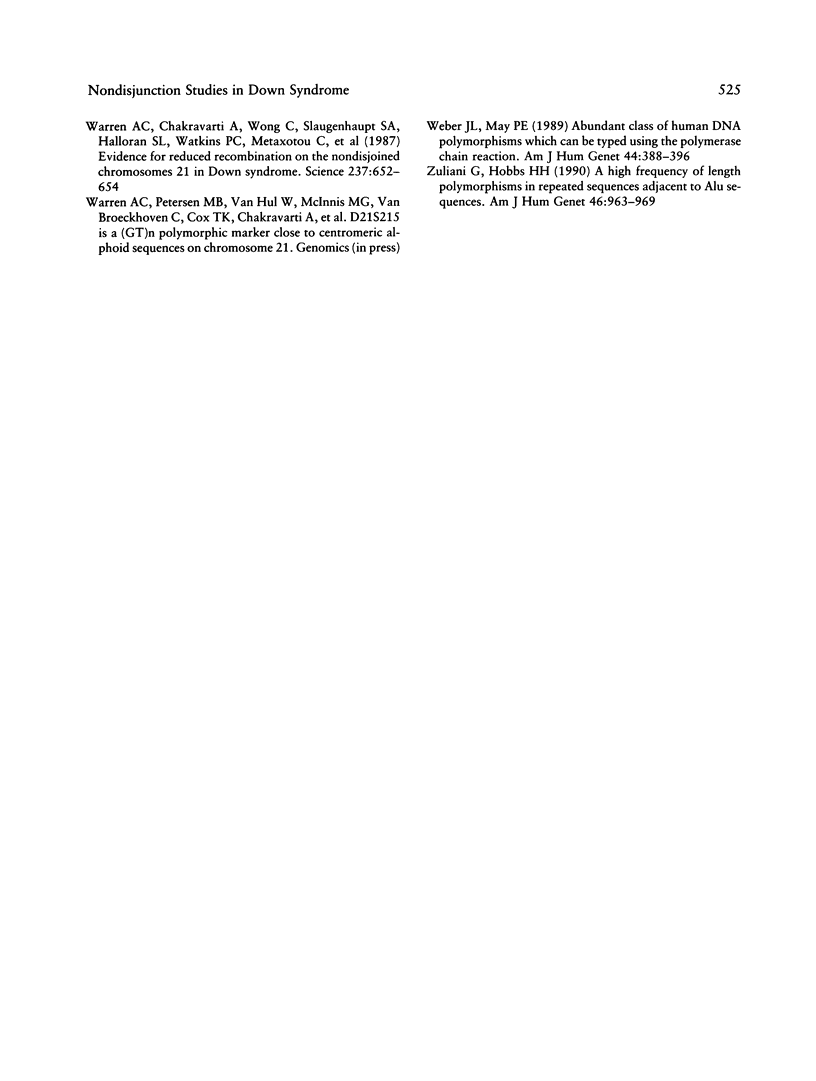
Images in this article
Selected References
These references are in PubMed. This may not be the complete list of references from this article.
- Antonarakis S. E., Kittur S. D., Metaxotou C., Watkins P. C., Patel A. S. Analysis of DNA haplotypes suggests a genetic predisposition to trisomy 21 associated with DNA sequences on chromosome 21. Proc Natl Acad Sci U S A. 1985 May;82(10):3360–3364. doi: 10.1073/pnas.82.10.3360. [DOI] [PMC free article] [PubMed] [Google Scholar]
- Antonarakis S. E. Parental origin of the extra chromosome in trisomy 21 as indicated by analysis of DNA polymorphisms. Down Syndrome Collaborative Group. N Engl J Med. 1991 Mar 28;324(13):872–876. doi: 10.1056/NEJM199103283241302. [DOI] [PubMed] [Google Scholar]
- Antonarakis S. E., Petersen M. B., McInnis M. G., Adelsberger P. A., Schinzel A. A., Binkert F., Pangalos C., Raoul O., Slaugenhaupt S. A., Hafez M. The meiotic stage of nondisjunction in trisomy 21: determination by using DNA polymorphisms. Am J Hum Genet. 1992 Mar;50(3):544–550. [PMC free article] [PubMed] [Google Scholar]
- Bricarelli F. D., Pierluigi M., Perroni L., Grasso M., Arslanian A., Sacchi N. High efficiency in the attribution of parental origin of non-disjunction in trisomy 21 by both cytogenetic and molecular polymorphisms. Hum Genet. 1988 Jun;79(2):124–127. doi: 10.1007/BF00280549. [DOI] [PubMed] [Google Scholar]
- Burmelster M., Cox D. R., Myers R. M. Dinucleotide repeat polymorphism located at D21S120. Nucleic Acids Res. 1990 Aug 25;18(16):4969–4969. doi: 10.1093/nar/18.16.4969. [DOI] [PMC free article] [PubMed] [Google Scholar]
- Chakravarti A., Slaugenhaupt S. A. Methods for studying recombination on chromosomes that undergo nondisjunction. Genomics. 1987 Sep;1(1):35–42. doi: 10.1016/0888-7543(87)90102-9. [DOI] [PubMed] [Google Scholar]
- Chakravarti A. The probability of detecting the origin of nondisjunction of autosomal trisomies. Am J Hum Genet. 1989 May;44(5):639–645. [PMC free article] [PubMed] [Google Scholar]
- Dagna Bricarelli F., Pierluigi M., Grasso M., Strigini P., Perroni L. Origin of extra chromosome 21 in 343 families: cytogenetic and molecular approaches. Am J Med Genet Suppl. 1990;7:129–132. doi: 10.1002/ajmg.1320370726. [DOI] [PubMed] [Google Scholar]
- Dagna Bricarelli F., Pierluigi M., Landucci M., Arslanian A., Coviello D. A., Ferro M. A., Strigini P. Parental age and the origin of trisomy 21. A study of 302 families. Hum Genet. 1989 Apr;82(1):20–26. doi: 10.1007/BF00288265. [DOI] [PubMed] [Google Scholar]
- Dausset J., Cann H., Cohen D., Lathrop M., Lalouel J. M., White R. Centre d'etude du polymorphisme humain (CEPH): collaborative genetic mapping of the human genome. Genomics. 1990 Mar;6(3):575–577. doi: 10.1016/0888-7543(90)90491-c. [DOI] [PubMed] [Google Scholar]
- Davies K. E., Harper K., Bonthron D., Krumlauf R., Polkey A., Pembrey M. E., Williamson R. Use of a chromosome 21 cloned DNA probe for the analysis of non-disjunction in Down syndrome. Hum Genet. 1984;66(1):54–56. doi: 10.1007/BF00275186. [DOI] [PubMed] [Google Scholar]
- Economou E. P., Bergen A. W., Warren A. C., Antonarakis S. E. The polydeoxyadenylate tract of Alu repetitive elements is polymorphic in the human genome. Proc Natl Acad Sci U S A. 1990 Apr;87(8):2951–2954. doi: 10.1073/pnas.87.8.2951. [DOI] [PMC free article] [PubMed] [Google Scholar]
- Galt J., Boyd E., Connor J. M., Ferguson-Smith M. A. Isolation of chromosome-21-specific DNA probes and their use in the analysis of nondisjunction in Down syndrome. Hum Genet. 1989 Jan;81(2):113–119. doi: 10.1007/BF00293885. [DOI] [PubMed] [Google Scholar]
- Hamers A. J., Meyer H., Jongbloed R. J., van der Hulst R. R., Geraedts J. P. Rate of recombination of chromosomes 21 in parents of children with Down syndrome. Clin Genet. 1990 Jun;37(6):463–469. doi: 10.1111/j.1399-0004.1990.tb03531.x. [DOI] [PubMed] [Google Scholar]
- Hassold T. J., Jacobs P. A. Trisomy in man. Annu Rev Genet. 1984;18:69–97. doi: 10.1146/annurev.ge.18.120184.000441. [DOI] [PubMed] [Google Scholar]
- Hassold T. J., Sherman S. L., Pettay D., Page D. C., Jacobs P. A. XY chromosome nondisjunction in man is associated with diminished recombination in the pseudoautosomal region. Am J Hum Genet. 1991 Aug;49(2):253–260. [PMC free article] [PubMed] [Google Scholar]
- Jabs E. W., Warren A. C., Taylor E. W., Colyer C. R., Meyers D. A., Antonarakis S. E. Alphoid DNA polymorphisms for chromosome 21 can be distinguished from those of chromosome 13 using probes homologous to both. Genomics. 1991 Jan;9(1):141–146. doi: 10.1016/0888-7543(91)90231-3. [DOI] [PubMed] [Google Scholar]
- Juberg R. C., Mowrey P. N. Origin of nondisjunction in trisomy 21 syndrome: all studies compiled, parental age analysis, and international comparisons. Am J Med Genet. 1983 Sep;16(1):111–116. doi: 10.1002/ajmg.1320160117. [DOI] [PubMed] [Google Scholar]
- Laurie D. A., Hultén M. A. Further studies on bivalent chiasma frequency in human males with normal karyotypes. Ann Hum Genet. 1985 Jul;49(Pt 3):189–201. doi: 10.1111/j.1469-1809.1985.tb01693.x. [DOI] [PubMed] [Google Scholar]
- Lewis J. G., Weber J. L., Petersen M. B., Slaugenhaupt S. A., Kwitek A., May P. E., Warren A. C., Chakravarti A., Antonarakis S. E. Linkage mapping of the highly informative DNA marker D21S156 to human chromosome 21 using a polymorphic GT dinucleotide repeat. Genomics. 1990 Oct;8(2):400–402. doi: 10.1016/0888-7543(90)90300-j. [DOI] [PubMed] [Google Scholar]
- Litt M., Luty J. A. A hypervariable microsatellite revealed by in vitro amplification of a dinucleotide repeat within the cardiac muscle actin gene. Am J Hum Genet. 1989 Mar;44(3):397–401. [PMC free article] [PubMed] [Google Scholar]
- McInnis M. G., Lutfalla G., Slaugenhaupt S., Petersen M. B., Uze G., Chakravarti A., Antonarakis S. E. Linkage mapping of highly informative DNA polymorphisms within the human interferon-alpha receptor gene on chromosome 21. Genomics. 1991 Nov;11(3):573–576. doi: 10.1016/0888-7543(91)90064-l. [DOI] [PubMed] [Google Scholar]
- Meijer H., Hamers G. J., Jongbloed R. J., Vaes-Peeters G. P., van der Hulst R. R., Geraedts J. P. Distribution of meiotic recombination along nondisjunction chromosomes 21 in Down syndrome determined using cytogenetics and RFLP haplotyping. Hum Genet. 1989 Oct;83(3):280–286. doi: 10.1007/BF00285173. [DOI] [PubMed] [Google Scholar]
- Mikkelsen M., Poulsen H., Grinsted J., Lange A. Non-disjunction in trisomy 21: study of chromosomal heteromorphisms in 110 families. Ann Hum Genet. 1980 Jul;44(Pt 1):17–28. doi: 10.1111/j.1469-1809.1980.tb00942.x. [DOI] [PubMed] [Google Scholar]
- Millington-Ward A. M., Pearson P. L. Use of restriction fragment length polymorphic probes in the analysis of Down's syndrome trisomy. Hum Genet. 1988 Dec;80(4):362–370. doi: 10.1007/BF00273652. [DOI] [PubMed] [Google Scholar]
- Morton N. E., Keats B. J., Jacobs P. A., Hassold T., Pettay D., Harvey J., Andrews V. A centromere map of the X chromosome from trisomies of maternal origin. Ann Hum Genet. 1990 Jan;54(Pt 1):39–47. doi: 10.1111/j.1469-1809.1990.tb00359.x. [DOI] [PubMed] [Google Scholar]
- Nielsen K. G., Poulsen H., Mikkelsen M., Steuber E. Multiple recurrence of trisomy 21 Down syndrome. Hum Genet. 1988 Jan;78(1):103–105. doi: 10.1007/BF00291249. [DOI] [PubMed] [Google Scholar]
- Perroni L., Dagna Bricarelli F., Grasso M., Pierluigi M., Baldi M., Pedemonte C., Strigini P. Crossing over and chromosome 21 nondisjunction: a study of 60 families. Am J Med Genet Suppl. 1990;7:141–147. doi: 10.1002/ajmg.1320370729. [DOI] [PubMed] [Google Scholar]
- Petersen M. B., Economou E. P., Slaugenhaupt S. A., Chakravarti A., Antonarakis S. E. Linkage analysis of the human HMG14 gene on chromosome 21 using a GT dinucleotide repeat as polymorphic marker. Genomics. 1990 May;7(1):136–138. doi: 10.1016/0888-7543(90)90531-x. [DOI] [PubMed] [Google Scholar]
- Petersen M. B., Schinzel A. A., Binkert F., Tranebjaerg L., Mikkelsen M., Collins F. A., Economou E. P., Antonarakis S. E. Use of short sequence repeat DNA polymorphisms after PCR amplification to detect the parental origin of the additional chromosome 21 in Down syndrome. Am J Hum Genet. 1991 Jan;48(1):65–71. [PMC free article] [PubMed] [Google Scholar]
- Petersen M. B., Slaugenhaupt S. A., Lewis J. G., Warren A. C., Chakravarti A., Antonarakis S. E. A genetic linkage map of 27 markers on human chromosome 21. Genomics. 1991 Mar;9(3):407–419. doi: 10.1016/0888-7543(91)90406-5. [DOI] [PubMed] [Google Scholar]
- Petersen M. B., Weber J. L., Slaugenhaupt S. A., Kwitek A. E., McInnis M. G., Chakravarti A., Antonarakis S. E. Linkage mapping of D21S171 to the distal long arm of human chromosome 21 using a polymorphic (AC)n dinucleotide repeat. Hum Genet. 1991 Aug;87(4):401–404. doi: 10.1007/BF00197156. [DOI] [PubMed] [Google Scholar]
- Rudd N. L., Dimnik L. S., Greentree C., Mendes-Crabb K., Hoar D. I. The use of DNA probes to establish parental origin in Down syndrome. Hum Genet. 1988 Feb;78(2):175–178. doi: 10.1007/BF00278191. [DOI] [PubMed] [Google Scholar]
- Saiki R. K., Scharf S., Faloona F., Mullis K. B., Horn G. T., Erlich H. A., Arnheim N. Enzymatic amplification of beta-globin genomic sequences and restriction site analysis for diagnosis of sickle cell anemia. Science. 1985 Dec 20;230(4732):1350–1354. doi: 10.1126/science.2999980. [DOI] [PubMed] [Google Scholar]
- Sherman S. L., Takaesu N., Freeman S. B., Grantham M., Phillips C., Blackston R. D., Jacobs P. A., Cockwell A. E., Freeman V., Uchida I. Trisomy 21: association between reduced recombination and nondisjunction. Am J Hum Genet. 1991 Sep;49(3):608–620. [PMC free article] [PubMed] [Google Scholar]
- Smeets H. J., Brunner H. G., Ropers H. H., Wieringa B. Use of variable simple sequence motifs as genetic markers: application to study of myotonic dystrophy. Hum Genet. 1989 Oct;83(3):245–251. doi: 10.1007/BF00285165. [DOI] [PubMed] [Google Scholar]
- Southern E. M. Detection of specific sequences among DNA fragments separated by gel electrophoresis. J Mol Biol. 1975 Nov 5;98(3):503–517. doi: 10.1016/s0022-2836(75)80083-0. [DOI] [PubMed] [Google Scholar]
- Stewart G. D., Harris P., Galt J., Ferguson-Smith M. A. Cloned DNA probes regionally mapped to human chromosome 21 and their use in determining the origin of nondisjunction. Nucleic Acids Res. 1985 Jun 11;13(11):4125–4132. doi: 10.1093/nar/13.11.4125. [DOI] [PMC free article] [PubMed] [Google Scholar]
- Stewart G. D., Hassold T. J., Berg A., Watkins P., Tanzi R., Kurnit D. M. Trisomy 21 (Down syndrome): studying nondisjunction and meiotic recombination by using cytogenetic and molecular polymorphisms that span chromosome 21. Am J Hum Genet. 1988 Feb;42(2):227–236. [PMC free article] [PubMed] [Google Scholar]
- Tautz D. Hypervariability of simple sequences as a general source for polymorphic DNA markers. Nucleic Acids Res. 1989 Aug 25;17(16):6463–6471. doi: 10.1093/nar/17.16.6463. [DOI] [PMC free article] [PubMed] [Google Scholar]
- Van Camp G., Backhovens H., Cruts M., Wehnert A., Van Hul W., Stinissen P., Van Broeckhoven C. Identification of chromosome 21 DNA polymorphisms for genetic studies in Alzheimer's disease and Down syndrome. Hum Genet. 1991 Oct;87(6):649–653. doi: 10.1007/BF00201718. [DOI] [PubMed] [Google Scholar]
- Warren A. C., Chakravarti A., Wong C., Slaugenhaupt S. A., Halloran S. L., Watkins P. C., Metaxotou C., Antonarakis S. E. Evidence for reduced recombination on the nondisjoined chromosomes 21 in Down syndrome. Science. 1987 Aug 7;237(4815):652–654. doi: 10.1126/science.2955519. [DOI] [PubMed] [Google Scholar]
- Weber J. L., May P. E. Abundant class of human DNA polymorphisms which can be typed using the polymerase chain reaction. Am J Hum Genet. 1989 Mar;44(3):388–396. [PMC free article] [PubMed] [Google Scholar]
- Zuliani G., Hobbs H. H. A high frequency of length polymorphisms in repeated sequences adjacent to Alu sequences. Am J Hum Genet. 1990 May;46(5):963–969. [PMC free article] [PubMed] [Google Scholar]
- del Mazo J., Pérez Castillo A., Abrisqueta J. A. Trisomy 21: origin of non-disjunction. Hum Genet. 1982;62(4):316–320. doi: 10.1007/BF00304546. [DOI] [PubMed] [Google Scholar]



